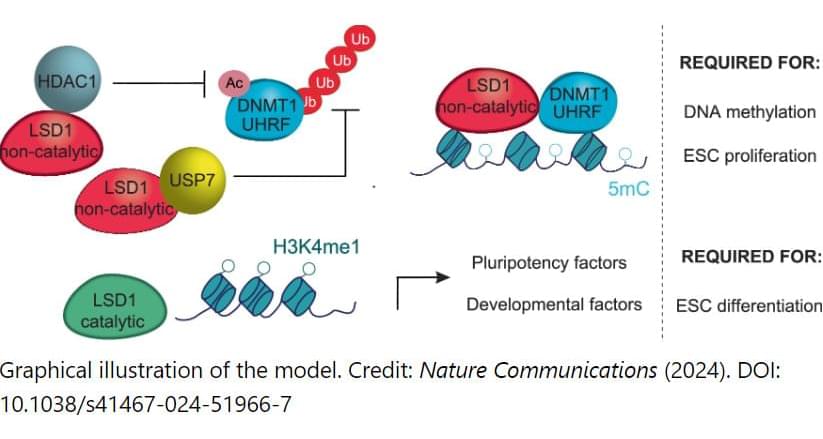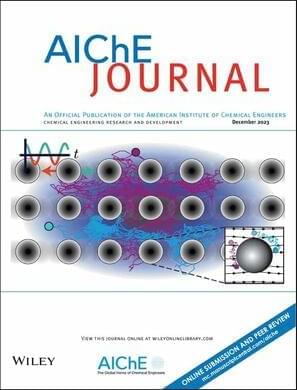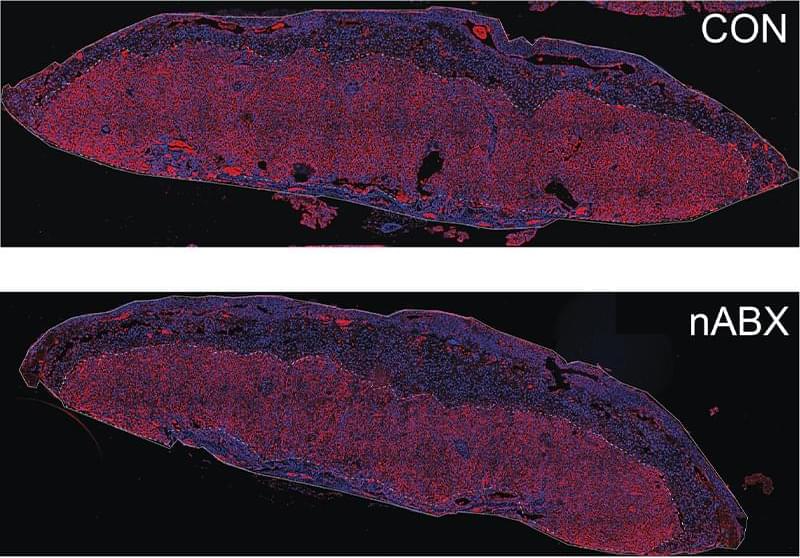NASA crew and ground-based scientists are sending blood cells to the International Space Station on November 4 to learn why astronauts have a higher risk of blood clots.



A study led by Umeå University, Sweden, presents new insights into how stem cells develop and transition into specialized cells. The discovery can provide increased understanding of how cells divide and grow uncontrollably so that cancer develops.
“The discovery opens a new track for future research into developing new and more effective treatments for certain cancers,” says Francesca Aguilo, associate professor at the Department of Molecular Biology at Umeå University and leader of the study in collaboration with various institutions including the University of Pavia, University of Texas Health Science Center at Houston, Universidad de Extremadura, and others.
All cells in the body arise from a single fertilized egg. From this single origin, various specialized cells with widely differing tasks evolve through a process called cellular differentiation. Although all cells share the same origin and share the same genetic information, specialized cells use the information in different ways to perform different functions. This process is regulated by genetic and epigenetic mechanisms.
On this episode, neuroscientist and author Robert Sapolsky joins Nate to discuss the structure of the human brain and its implication on behavior and our ability to change. Dr. Sapolsky also unpacks how the innate quality of a biological organism shaped by evolution and the surrounding environment — meaning all animals, including humans — leads him to believe that there is no such thing as free will, at least how we think about it today. How do our past and present hormone levels, hunger, stress, and more affect the way we make decisions? What implications does this have in a future headed towards lower energy and resource availability? How can our species manage the mismatch of our evolutionary biology with our modern day challenges — and navigate through a ‘determined’ future?
About Robert Sapolsky:
Robert Sapolsky is professor of biology and neurology at Stanford University and a research associate with the Institute of Primate Research at the National Museum of Kenya. Over the past thirty years, he has divided his time between the lab, where he studies how stress hormones can damage the brain, and in East Africa, where he studies the impact of chronic stress on the health of baboons. Sapolsky is author of several books, including Why Zebras Don’t Get Ulcers, A Primate’s Memoir, Behave: The Biology of Humans at Our Best and Worst, and his newest book coming out in October, Determined: Life Without Free Will. He lives with his family in San Francisco.
For Show Notes and More visit: https://www.thegreatsimplification.co…
00:00 — Episode highlight.
00:15 — Guest introduction.
03:10 — When did Robert know he wanted to study animal behavior?
04:40 — When was his last research trip?
05:46 — Challenges that come from differences from modern and ancestral environments.
07:20 — Physiology and our emotions.
09:37 — Divide in evolutionary beliefs.
12:13 — Behavioral science and religion.
14:40 — Past students’ impacted by Robert.
16:48 — Testosterone.
21:07 — Dopamine.
29:02 — Oxytocin.
32:19 — Hormones affecting social behavior.
38:21 — Changing the environmental stimuli of pregnant people to positively impact fetus’ development.
41:55 — Free will.
57:24 — Science of attractiveness.
58:55 — Do people have free will?
1:13:12 — Emergence.
1:18:17 — Quantum and indeterminacy.
1:19:18 — Complexity of free will.
1:23:46 — Difference between free will and agency.
1:26:43 — How to use Robert’s work to change policies around the world in a positive way.
1:29:15 — What’s the difference between a deterministic world and a fatalistic one?
1:34:39 — Robert’s thoughts on his newest book, Determined: Life Without Free Will.
1:40:48 — Key components in a new systems society understanding this science.
1:45:30 — What should listeners take away from this podcast?
1:47:32 — Robert’s recommendations for the polycrisis.
1:52:20 — What Robert cares most about in the world.
1:53:00 — Robert’s magic wand.
1:54:36 — Future topics of conversations.
#natehagens #thegreatsimplification #neuroscience #dopamine #freewill #testosterone

Researchers connecting pieces of the massive Alzheimer’s puzzle are closer to slotting the next one in place, with yet another link between our guts and brain.
Animal studies have demonstrated Alzheimer’s can be passed on to young mice through a transfer of gut microbes, confirming a link between the digestive system and the health of the brain.
A 2023 study adds further support to the theory that inflammation could be the mechanism through which this occurs.

At some point in your life, you must’ve experienced a lightbulb moment when an amazing idea just popped into your head out of nowhere. But what is your brain doing during these brief periods of creativity?
Researchers from the University of Utah Health and Baylor College of Medicine looked into the origin of creative thinking in the brain. They found that different parts of the brain work together to produce creative ideas, not just one particular area.
“Unlike motor function or vision, they’re not dependent on one specific location in the brain,” Ben Shofty, the senior author of the study and an assistant professor of neurosurgery at the Spencer Fox Eccles School of Medicine, said. “There’s not a creativity cortex.”

Bioengineered bacteria to eat plastic in seawater:3 Which in large quantities can eat all the plastic in the ocean:3 Yay face_with_colon_three
Poly(ethylene terephthalate) (PET) is a highly recyclable plastic that has been extensively used and manufactured. Like other plastics, PET resists natural degradation, thus accumulating in the environment. Several recycling strategies have been applied to PET, but these tend to result in downcycled products that eventually end up in landfills. This accumulation of landfilled PET waste contributes to the formation of microplastics, which pose a serious threat to marine life and ecosystems, and potentially to human health. To address this issue, our project leveraged synthetic biology to develop a whole-cell biocatalyst capable of depolymerizing PET in seawater environments by using the fast-growing, nonpathogenic, moderate halophile Vibrio natriegens. By leveraging a two-enzyme system—comprising a chimera of IsPETase and IsMHETase from Ideonella sakaiensis —displayed on V. natriegens, we constructed whole-cell catalysts that depolymerize PET and convert it into its monomers in salt-containing media and at a temperature of 30°C.

There are rare cells in the gut called enteroendocrine cells (EECs) that could be manipulated in a variety of ways to detect or treat disease.
The trillions of microbes in our gastrointestinal tract, known as the gut microbiome, are crucial to the body; the gut microbiome aids in digestion, nutrient absorption, and influences our health in different ways. But the body also has to be protected from all of those microbes, which are kept behind a tight barrier. But if the intestinal barrier is dysfunctional, or leaky, serious problems can arise.
There are cells in the gut called enteroendocrine cells (EECs) that can generate hormones, which may have a variety of effects on the body. EECs release hormones in response to cues like food intake and stomach stretching. The hormones can then influence physiological processes related to digestion or appetite. Scientists have now found receptors on EECs that control hormone release. It may one day be possible to alter these receptors to treat disease. The research has been reported in Science.
Researchers at The Jackson Laboratory (JAX), the Broad Institute of MIT and Harvard, and Yale University, have used artificial intelligence to design thousands of new DNA switches that can precisely control the expression of a gene in different cell types. Their new approach opens the possibility of controlling when and where genes are expressed in the body, for the benefit of human health and medical research, in ways never before possible.
“What is special about these synthetically designed elements is that they show remarkable specificity to the target cell type they were designed for,” said Ryan Tewhey, PhD, an associate professor at The Jackson Laboratory and co-senior author of the work. “This creates the opportunity for us to turn the expression of a gene up or down in just one tissue without affecting the rest of the body.”
In recent years, genetic editing technologies and other gene therapy approaches have given scientists the ability to alter the genes inside living cells. However, affecting genes only in selected cell types or tissues, rather than across an entire organism, has been difficult. That is in part because of the ongoing challenge of understanding the DNA switches, called cis-regulatory elements (CREs), that control the expression and repression of genes.

ABOVE: The placenta’s labyrinth zone (red), responsible for nutrient exchange between mother and fetus, is reduced in fetuses with dysbiotic fathers (lower panel) compared to healthy fathers (upper panel). Ayele Argaw-Denboba.
The microbiome has a profound impact on host health that extends to the host’s young ones. Studies in mice have shown that maternal gut bacteria play a role in offspring behavior and placental growth during pregnancy.1,2 Yet, the effects of the paternal microbiome on the health of their progeny remained relatively unexplored.
In a new study, scientists found that altering the gut microbiome of male mice negatively affected the health and lifespan of their offspring through epigenetic changes in the sperm.3 The results, published in Nature, offer insights into a gut-germline axis that mediates the effects of the microbiome on health and disease across generations.